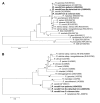Human infections with Rickettsia raoultii, China
- PMID: 24750663
- PMCID: PMC4012798
- DOI: 10.3201/eid2005.130995
Human infections with Rickettsia raoultii, China
Abstract
We used molecular methods to identify Rickettsia raoultii infections in 2 persons in China. These persons had localized rashes around sites of tick bites. R. raoultii DNA was detected in 4% of Dermacentor silvarum ticks collected in the same area of China and in 1 feeding tick detached from 1 patient.
Keywords: China; Dermacentor silvarum; Rickettsia raoultii; human infections; rickettsia; ticks; vector-borne infections.
Figures

References
-
- Speck S, Derschuma H, Damdindorj T, Dashdavaa O, Jiang J, Kaysser PB, et al. Rickettsia raoultii, the predominant Rickettsia found in Mongolian Dermacentor nuttalli. Ticks Tick Borne Dis. 2012;3:227–31. - PubMed
Publication types
MeSH terms
Substances
LinkOut - more resources
Full Text Sources
Other Literature Sources

